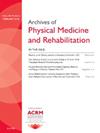评估干针在住院治疗中综合疼痛管理中的应用[j]
IF 3.6
2区 医学
Q1 REHABILITATION
Archives of physical medicine and rehabilitation
Pub Date : 2025-04-01
DOI:10.1016/j.apmr.2025.01.057
引用次数: 0
摘要
虽然干针(DN)已被用于各种门诊治疗疼痛,但这是第一个分析成人住院康复期间DN的研究。主要目的:探讨DN对疼痛管理的影响。次要目的:探讨DN对日常活动、睡眠、焦虑、治疗依从性和药物使用的影响。本试验为随机对照试验,采用平行组设计,1:1分配比例。这项研究是在北卡罗莱纳州夏洛特市的Atrium健康卡罗莱纳康复中心进行的,这是一家位于城市环境中的非营利性住院康复医院,附属于创伤1医疗中心。参与者从便利的样本中招募了42名成年人,他们在一家机构接受住院康复治疗,该机构为不同的患者群体提供服务,包括脑损伤、脊髓损伤、肿瘤疾病和各种复杂的医学诊断。干预措施本研究的两组随机分为两组,分别接受DN联合手工治疗或仅用于疼痛管理的手工治疗。所有受试者均接受住院康复医院的“常规护理”,包括身体、职业和/或语言治疗以及护理和医疗干预。主要结局指标包括疼痛视觉模拟量表、患者报告的结果测量信息系统(PROMIS)疼痛干扰、睡眠障碍和情绪困扰-焦虑问卷、患者因疼痛而拒绝治疗的时间以及PRN止痛药的使用。结果两组治疗前后疼痛的视觉模拟量表、疼痛干扰的PROMIS和情绪困扰焦虑的PROMIS均有显著改善。未发现promise -睡眠障碍、治疗拒绝或使用止痛药的变化。治疗后两组在任何结果测量上均无显著差异。结论:本研究强调了MT和DN作为住院治疗期间疼痛的辅助治疗的益处。未发生不良事件,表明在复杂医疗状态的成人住院康复中,DN是安全可行的。本文章由计算机程序翻译,如有差异,请以英文原文为准。
Assessing the Use of Dry Needling for Integrative Pain Management During Inpatient Therapy 1142
Objectives
Although dry needling (DN) has been used in a variety of outpatient settings to address pain, this is the first study analyzing DN with adults during inpatient rehabilitation. Primary objectives: to examine the effects of DN for pain management. Secondary objectives: to explore the effects of DN on daily activities, sleep, anxiety, therapy compliance, and medication usage.
Design
This was a randomized controlled trial with a parallel-group design and 1:1 allocation ratio.
Setting
The study was conducted at Atrium Health's Carolinas Rehabilitation in Charlotte, North Carolina, which is a non-profit inpatient rehabilitation hospital in an urban setting attached to a Trauma-1 Medical Center.
Participants
Forty-two adults were enrolled from a sample of convenience while undergoing inpatient rehabilitation in a facility that serves a diverse patient population including individuals post brain injury, spinal cord injury, oncological disease, and a variety of complex medical diagnoses.
Interventions
The 2 groups in this study were randomized to receive DN with manual therapy or manual therapy treatments only for pain management. All subjects received the “usual care” of the inpatient rehabilitation hospital including physical, occupation, and/or speech therapy treatments as well as nursing and medical interventions.
Main Outcome Measures
Outcomes included the Visual Analog Scale for Pain, Patient-Reported Outcomes Measurement Information System (PROMIS) questionnaire for Pain Interference, Sleep Disturbance, and Emotional Distress-Anxiety, the amount of time patients refused therapy due to pain, and PRN pain medication use.
Results
Both groups demonstrated significant improvements pre-post treatment on visual analog scale for pain, PROMIS for pain interference, and PROMIS for emotional distress-anxiety. No changes were found for PROMIS—sleep disturbance, therapy refusals, or use of pain medication. There were no significant differences between groups on any outcome measure after treatment.
Conclusions
This research highlights the benefits of both MT and DN as an adjunct treatment for pain during inpatient therapy. No adverse events occurred showing that DN is safe and feasible during inpatient rehabilitation with adults in a complex medical state.
Disclosures
none.
求助全文
通过发布文献求助,成功后即可免费获取论文全文。
去求助
来源期刊
CiteScore
6.20
自引率
4.70%
发文量
495
审稿时长
38 days
期刊介绍:
The Archives of Physical Medicine and Rehabilitation publishes original, peer-reviewed research and clinical reports on important trends and developments in physical medicine and rehabilitation and related fields. This international journal brings researchers and clinicians authoritative information on the therapeutic utilization of physical, behavioral and pharmaceutical agents in providing comprehensive care for individuals with chronic illness and disabilities.
Archives began publication in 1920, publishes monthly, and is the official journal of the American Congress of Rehabilitation Medicine. Its papers are cited more often than any other rehabilitation journal.

 求助内容:
求助内容: 应助结果提醒方式:
应助结果提醒方式:


